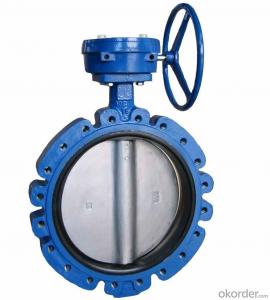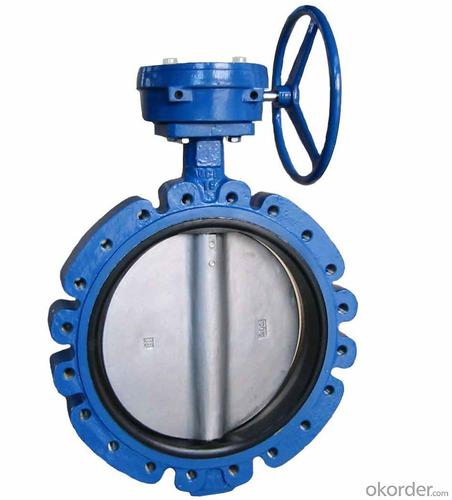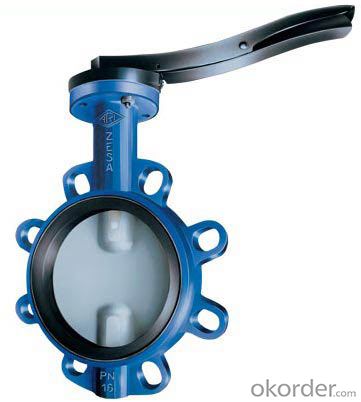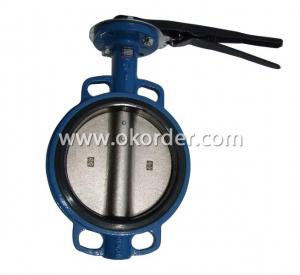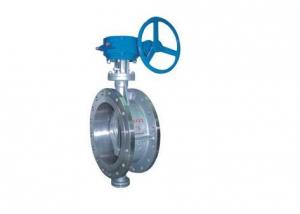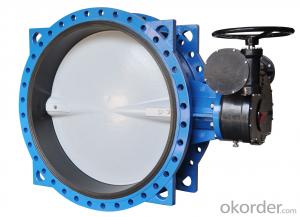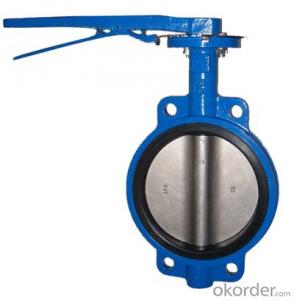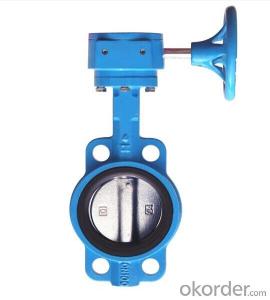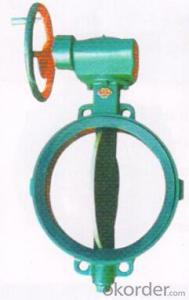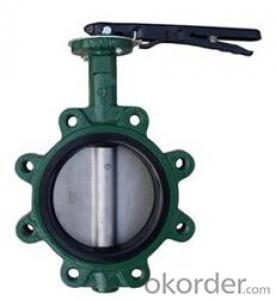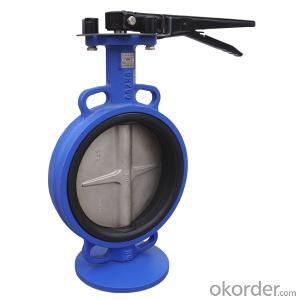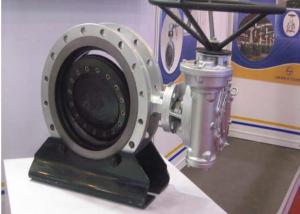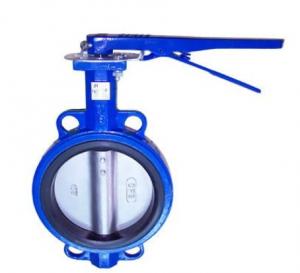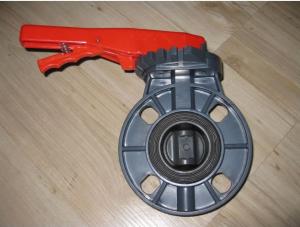Butterfly Valve Turbine Type DN150 BS Standard
- Loading Port:
- Tianjin
- Payment Terms:
- TT OR LC
- Min Order Qty:
- 50 pc
- Supply Capability:
- 5000 pc/month
OKorder Service Pledge
OKorder Financial Service
You Might Also Like
1. Manual Wafer Butterfly Valve Description:
A butterfly valve is a valve which can be used for isolating or regulating flow. The closing mechanism takes the form of a disk. Operation is similar to that of a ball valve, which allows for quick shut off. Butterfly valves are generally favored because they are lower in cost to other valve designs as well as being lighter in weight, meaning less support is required. The disc is positioned in the center of the pipe, passing through the disc is a rod connected to an actuator on the outside of the valve. Rotating the actuator turns the disc either parallel or perpendicular to the flow. Unlike a ball valve, the disc is always present within the flow, therefore a pressure drop is always induced in the flow, regardless of valve position.
2.Main Features of the Manual Wafer Butterfly Valve
a)Cast hole. Flange connection meet ANSI 125/150# DIN PN10/16 BS4504 PN10/16 in the meanwhile.
b)Soft seat. Replaceable. Increase of service life.
c)Double half shaft without pin.
d) Square and short neck. Easy to stick scutcheon and cost saving.
3. Manual Wafer Butterfly Valve Images:

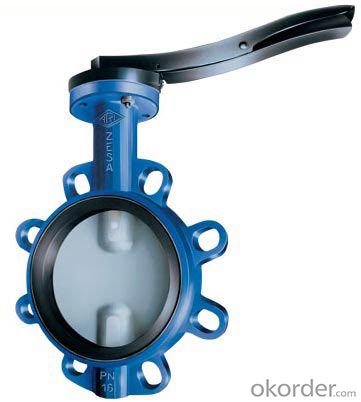
4.Manual Wafer Butterfly Valve Specification:
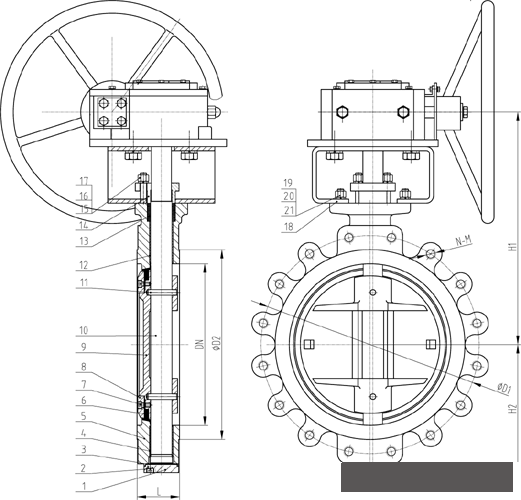
5.FAQ
1. What is manual wafer butterfly valve?
A: Wafer style is the more common of the two and is less expensive than the lug style. The wafer style butterfly valve is just about the standard. It ís so common that no one even bothers to use the word "wafer" when ordering a butterfly valve. It is taken for granted that if a butterfly valve is ordered, a wafer style will be received.
2. How about the Installation of the Wafer Style Butterfly Valve?
A: Butterfly valves are installed by inserting the valve between two flanges using bolts or studs and nuts to hold it all together. This type of installation, of course, makes it impossible to disconnect just one side of the piping system from the valve. That benefit is received using the lug style valve.
3. What is the working principle of manual wafer butterfly valve?
A: A butterfly valve is from a family of valves called quarter-turn valves. In operation, the valve is fully open or closed when the disc is rotated a quarter turn. The "butterfly" is a metal disc mounted on a rod. When the valve is closed, the disc is turned so that it completely blocks off the passageway. When the valve is fully open, the disc is rotated a quarter turn so that it allows an almost unrestricted passage of the fluid. The valve may also be opened incrementally to throttle flow.
- Q: What do you mean, handle, butterfly valve, hard back and soft back?
- My understanding is: PTFE butterfly valve is a hard back; soft rubber seat is a soft back
- Q: I got my timing belt done on a 1999 Civic Si on September 26 @ 113,699 miles. at 116,9xx miles I bent a valve on my third cylinder. How likely is it that the timing belt is the reason why this happened? I heard that if the timing belt is a tooth or so off, it could bend a valve. So is it likely that this could have happened? Anyway to check?
- If it was a timing belt issue it woudn't have only been one cylinder. And usually if it's only off by one tooth, it just runs poorly. IT has to be off by quite a bit, or the belt has to straight up break to bend a valve,, if that happened it would have made a horrible clanging noise repeatedly before it eventually sputtered out. the 1999 Si revs to what... 8000 rpms? You didn't happen to miss a shift and over-rev the engine, did you?
- Q: Model specification for butterfly valves
- 1. classification by structure(1) Central sealed butterfly valve (2) single eccentric sealed butterfly valve (3) double eccentric sealed butterfly valve (4) three eccentric sealed butterfly valve2. by secret cover material classification(1) soft sealing butterfly valve. (2) metal hard sealing butterfly valve.3. classified by seal type(1) forced sealing butterfly valve (2) pressure sealed butterfly valve. (3) automatic sealing butterfly valve. The pressure of the seal is automatically generated by the pressure of the medium.4. classification by work pressure(1) vacuum butterfly valve. Butterfly valve with lower working pressure than standard atmosphere. (2) low pressure butterfly valve. Butterfly valve with nominal pressure PN<1.6MPa. (3) medium pressure butterfly valve. Butterfly valve with nominal pressure PN 2.5--6.4MPa. (4) high pressure butterfly valve. Nominal pressure PN is 10. 0--80.0MPa butterfly valve. (5) ultra high pressure butterfly valve. Butterfly valve with nominal pressure PN>100MPa.5. classification by operating temperature(1) high temperature butterfly valve. T>450 degrees C butterfly valve (2) medium temperature butterfly valve. 120 C6. classification by connection1 pairs of clip butterfly valve2, flange butterfly valve (3) lug butterfly valve. (4) welded butterfly valve.
- Q: How is the lug butterfly valve connected to the flange?
- It is clip type butterfly valve.Connection way is to use butterfly flange flange.The sealing surfaces at the ends of the two rubber sealing rings are respectively butted with the welded flanges welded on the pipe; the two headed screws and the nuts are used for fastening.
- Q: Butterfly valve D71X-1.6C, DN50, there is no difference between C and no C? What do you mean by "concrete"?
- The C indicates that the material is carbon steel and does not indicate cast iron (generally omitted)
- Q: Hi guys, i asked a question before pertaining to the amount of cylinders and asking if it meant V4 or V6 or whatever.I actually meant to say VALVES, not cylinders. IS there a direct correlation between VALVES and Clyinders..Eg, My car, which is a 2001 Neon LE states right on the engine block quot;16 VALVEquot; in bright letters. I am sure this is a 4 cylinder engine. I haven't had a car that broadcasted the number of VALVES before. Another car I had broadcast that is was a 3.3 Liter V6 right on the engine.Is there a mathematical relationship between VALVES and cylinders, or would my car be braodcasting 16 VALVES, because a 4 cylinder doesn't typically HAVE 16 valves, or what is the story??Recently, I was looking at an altima, and it said 24 valves. Can you tell just by the number of valves if it is a 4 cylinder or 6 cylinder or whatever??Thanks.
- for every cylinder there is 4 valves..
- Q: I need a valve cover gasket replacement because mine is leaking a tremendous amount of oil. The mechanic says it will cost about $269.00 plus tax. I wanted to make sure this figure was the average since I do not know a lot about cars. My car is a Mitsubishi Diamante 2001.
- its a little high at our shop its about $200
- Q: D341W-10P-400 butterfly valve, what does each alphanumeric letter mean?
- According to JB/T308-2004 "valve type programming method"D butterfly valve3 worm gear4 flange connection1 Structure: sealed type, central vertical plateW sealing material for valve body material10 nominal pressure PN10P body material is chromium nickel stainless steel400 shall be nominal size DN400
- Q: butterfly valves d7a1x5
- D- valve type (butterfly valve), 7- connection mode (to clamp), A- valve shape mode (A), 1- structure form (vertical plate), X5- valve seat sealant species (Ding Qing, NBR)
- Q: What's the meaning of butterfly valve d371po?
- According to the provisions of the JB/T 308-2004 valve type programming method:D== butterfly valve3== transmission: worm gear7== connection mode: clip type1== structure: midlinePo== sealing surface material: lining PoPo== propylene oxide (PO)
Send your message to us
Butterfly Valve Turbine Type DN150 BS Standard
- Loading Port:
- Tianjin
- Payment Terms:
- TT OR LC
- Min Order Qty:
- 50 pc
- Supply Capability:
- 5000 pc/month
OKorder Service Pledge
OKorder Financial Service
Similar products
Hot products
Hot Searches
Related keywords
